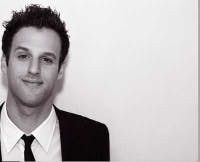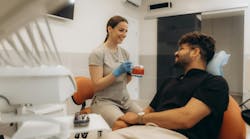Beyond esthetics to great patient relationships
By Joshua Polansky, BS, MDCAt the UCLA Center for Esthetic Dentistry, I get a chance to work directly with patients. I work side by side with dentists, trying to achieve maximum esthetics. As a young technician, new to the field, I have been striving for “the answer” to all of the technical questions. I have mimicked all I have seen and heard from the best in the business. I have collected and examined natural teeth, carved teeth from stone, drawn teeth by day and night, and photographed my work with all types of lighting. For the last several years, I have become so obsessed with teeth that I even dream about them. I became so focused on teeth that I forgot there was a human being attached to them. My “aha” moment came when I realized there was more involved in being a technician than just the right shape or shade of a tooth. Early on I had an experience that changed the way I look at my work. I made what I thought to be my best veneers. I worked hard, and I was certainly proud that I had made my very best effort. I looked forward to showing off my work to the dentist and the patient. I went through my mental checklist; I thought I had all the criteria for a great case. My contour was natural, internal effects were just right, and the color was spot on. Everything that I had learned over the years went into these veneers. We tried the case in, stepped back, and smiled at one another. I handed the mirror to the patient. I could tell immediately that she was less than pleased ... but I wasn’t ready for her to tell me she hated them.I was devastated!I take rejection very personally and said to myself, “She’s crazy!”Or was she?Is all of this technical work that we spend so much time perfecting really about the teeth, or is it about the patient? I began to see the bigger picture. The answer to this question wasn’t that my patient was crazy; it was her perception of beauty that had to be satisfied. If not, there would be no communication. I have witnessed this over and over in my short career. We become so tied to our work, our skills, and our technology, that we lose sight of the patient.I now know that working directly with patients provides the context and the meaning for our work.It’s time for our profession to go beyond the teeth and technology, and create great relationships with doctors and patients so we will never again say, “She’s crazy.”If we begin to create these relationships, we will surely achieve greater doctor and patient acceptance and compliance. We will also come to love our work more. The patient is our canvas and context in which to provide meaning for our work.We spend hours and hours learning our trade. We try to become the very best in our field, yet I meet so many wonderfully talented technicians who never get to do the work they are capable of doing. I understand dentists suffer from the same issues. I wonder, when it comes to having real success, is talent overrated? Or do we need to learn other skills and habits to truly become masters? I came into this industry to earn a great living and to do meaningful work. It seems that the meaningful work part is a problem in our field.By putting the patient into the equation, all of us — the dentists and the technicians — get closer to our end product and the end user. Think about how cars are manufactured. Sometimes it feels we are just on an assembly line, never knowing where the car is going ... only hoping that somewhere there is someone who appreciates our work. The technician’s work is important, and this shouldn’t be a thankless job. By putting the patient into the equation, a whole new set of variables comes about. I wasn’t just dealing with stone and porcelain anymore. My stone now had blood running through it, and my porcelain was staring back at me telling me what she liked and didn’t like.We need to apply a whole new set of skills beyond our technical ability — people skills. Just think how you would feel if someone thought you were “crazy” because you didn’t like something you were about to purchase? How hard is it to drop the attachment to our work, apologize, ask for input and feedback, and just say, “You’re right”? After all, feelings are facts to the people who have them.
Before and after (actually a pre-op photo as well –- the patient didn’t trust her previous dentist, so she came to us with prepped teeth)This concept really hit home the next day when I was meeting with another patient to start a case. Like many technicians, I couldn’t wait to introduce myself, take the shade, and get back to my bench as soon as possible. This time, however, I told myself I would do things differently. I would not only focus on just the patient’s teeth, but the whole person. I would try to get to know the patient. I would try to understand my patient’s goals. I would learn this person’s communication style and try to understand if there would be any constraints or compromises to treatment. I would become a partner with the doctor to help create a vision for the patient and communicate it thoroughly before we became too involved in the case. I would begin a relationship with the patient.As time went on, I couldn’t believe the impact my relationships with patients had on my work. Nothing technically changed about my working style, but I saw a dramatic increase in my patients’ and doctors’ satisfaction with my work. Maybe it was more satisfying working with me than it being all about the final product. When communication gets better, the work seems frictionless. Now, when meeting patients for the first time, their teeth aren’t my first priority. That will come later like it always does. Now, most importantly, my goal is to establish a more personal relationship with my patients, letting them know that they can trust me and that they are in good hands. By allowing the patient to feel this comfort level with you, there is almost a feeling of success before the stone even gets poured.This “aha” experience changed the way I look at dental technology. We need to get beyond the “she’s crazy” attitude by creating better relationships with our doctors and their patients.I suggest that you send this article to all of the doctors you currently work with as a way of opening your lines of communication. Take courses or read books on communication and listening skills. It all starts with you.
A happy “after” photo of a satisfied patientThis new skill will dramatically change the way you practice. You will visibly see more patient acceptance, more profit, and, overall, a higher quality of job satisfaction. To be a successful dental technician in today’s world, great technical ability just won’t cut it anymore. We have to stop working in a vacuum. We have to realize that there is an end user who has feelings, expectations, and a schedule just like we do. We have to realize that it’s not all about the teeth; it’s all about the patient.
Joshua Polansky, BS, MDC, earned his Bachelor of Arts degree, summa cum laude, from Rutgers University in 2004. While working part time at a dental laboratory, he took advantage of an opportunity to apprentice with distinguished master technician, Olivier Tric. Mr. Tric opened Joshua's eyes to a whole new world of possibilities. He made the decision to become a master dental technician following the path that Tric had forged. He continued to acquire technical skills by studying in Europe with other mentors and experts in the field. Joshua currently resides in Los Angeles, Calif., where he is earning his master’s degree in dental ceramics at the UCLA Center for Esthetic Dentistry under Dr. Edward Mclaren. Joshua is the owner and operator of Niche Dental Arts, a collaborative boutique dental laboratory with his father, Dr. Barry Polansky. Contact Joshua at his blog http://nichedentalarts.blogspot.com/.





